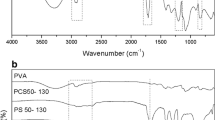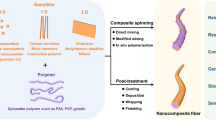Abstract
An experimental study of the dichroism of uniaxial and biaxial orientation of polyethylene terephthalate films containing dichroic dyestuffs is described. It is found that hydrophobic dyestuffs orient more and cause greater dichroism than do hydrophilic dyes. Dyestuffs which can induce dichroism in cellulosic films are not effective with PET films. The more anisotropic the hydrophobic dyestuff molecule, the more effective it is in inducing dichroism. At low stretch ratios, the dichroism (D 12−1)/(D 12+2) (whereD 12 isA 1/A2) increases linearly with birefringence, but at higher stretch ratios the rate of increase is slower. This may be attributed to crystallization and reduced orientations in the amorphous regions. Biaxial stretching generally lowersD 12.
Similar content being viewed by others

References
Brewster D (1819) Phil Trans Roy Soc 109:11
Ambronn H (1888) Ann Phys and Chem 34:346
Zocher H (1925) Naturwiss 13:1015
Preston JM (1931) J Soc Dyers Colourists 47:312
Morey DR (1935) Textile Res J 5:105
Okajima S, Kobayashi S (1946) Nippon Kagakukai-shi (J Soc Chem Ind) 49:38
Preston JM, Tsien PC (1946) J Soc Dyers Colourists 62:368
Preston JM, Tsien PC (1950) J Soc Dyers Colourists 66:361
Hermans PH, Heikens D (1952) Rec Trav Chim 71:49
Land EH (1933) US Patent 1,918,848
Land EH, West CD (1946) in ‘Colloid Chemistry’, Vol 6, Edited by J Alexander Reinhold, NY
Nozu T, Ichikawa R, Hitomi T, Wada M (1982) Japanese Patent Kokai57-84409
Yamada Y, Nishizawa I, Fujisawa J, Hosonuma M (1983) Japanese Patent Kokai 58-68008
Patterson D, Ward IM (1957) Trans Faraday Soc 53:1516
Chappel FP (1960) Polymer 1:410
Nakayama K, Okajima S, Kobayashi Y (1969) J Appl Polym Sci 13:659
Okajima S, Nakayama K, Kayama K, Kato Y (1970) J Appl Polym Sci 14:1069
Hermans PH, Platzek P (1939) Kolloid Z 88:68
Muller FH (1941) Kolloid Z 95:138
Nomura S, Kawai H, Kimura I, Kagiyama M (1967) J Polym Sci A-2 5:479
White JL, Spruiell JE (1981) Polym Eng Sci 21:859
White JL (1985) J Polym Eng 5:275
Schmidt PG (1963) J Polym Sci A 1:1271
Okajima S, Koizumi Y (1939) Kogyo Kagaku Zasshi, 42:810
Samuels RJ (1981) J Appl Polym Sci 26:1383
Cakmak M, White JL, Spruiell JE (1989) Polym Eng Sci 29:1534
Dulmage WJ, Geddes AL (1958) J Polym Sci 31:499
Hefflefinger CJ, Schmidt PG (1965) J Appl Polym Sci 9:2661
Cakmak M, White JL, Spruiell JE (1986) J Polym Eng 5:291
Sakaguchi N, Oda T, Nakai A, Kawai H (1977) Sen-i Gakkaishi, 33:T-499
Author information
Authors and Affiliations
Rights and permissions
About this article
Cite this article
Watanabe, T., White, J.L. Dichroic polyethylene terephthalate films based upon compounds containing dyestuffs. Colloid Polym Sci 270, 519–526 (1992). https://doi.org/10.1007/BF00658282
Received:
Accepted:
Issue Date:
DOI: https://doi.org/10.1007/BF00658282



